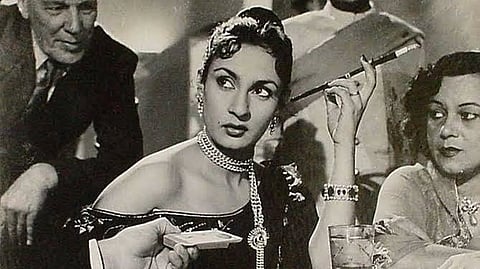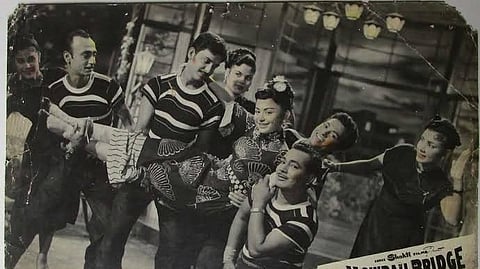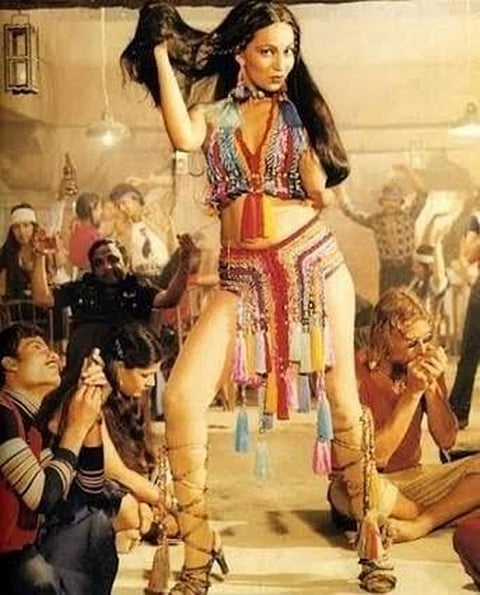The Bollywood vamp from the 50s till the 90s was the perfect anti-heroine.
The vamps were known for their sizzling dance moves and their smoking bold characters.
Always western in her influence, the vamp was the only representation of “the progressive woman” for a long time in Hindi cinema.
Retro Express | Forget The Sona, I Miss My Mona Darling!
The Bollywood vamp has been missing from the scene for a few decades now, with item numbers trying to make up for her absence and failing
I miss the Bollywood vamp. She had vavavoom. She was fashionable, independent, drove a car, wore fancy sunglasses and hats, loved to party, was outspoken and often a tease. She owned her sexuality, she loved to drink and smoke (and occasionally blow smoke rings). Think Nadira, Shashikala, Bindu, Helen, Aruna Irani.
She could be a gangster’s sidekick, a smuggler’s P.A (who always knew where the sona was at any given point in time), often the mistress, a scheming criminal, a cruel mother-in-law or sister-in-law, a sexy cabaret dancer or just a mean rich girl who doesn’t like the hero romancing the wimpy heroine. “Nice girl” is clearly not what the vamp was going for and yet, she wouldn’t settle for less than the hero.

Her promiscuity was unapologetic, her dialogues campy, her wickedness almost delicious, syrupy. She often displayed husband/boyfriend-stealing impulses and her plunging neckline was her trademark. To this visual image, now add big, stylish hair, loud makeup, a cigarette and a glass of whisky (wine is too mild for her). She was what our chaste heroines of yore could never be and somehow, she always seemed to have more of a ‘life’. Nadira as Maya in Shree 420 (1955) in her black gowns and diamonds seems to be having a lot more fun (even with the hero, Raj Kapoor) than poor Miss Goody Two-shoes in sarees, Nargis.

For all her charisma and gravitas, she had a set menu of actions. But then, at the time, she was the only representation of “the progressive woman”. She would shake a leg at a party for smugglers (later, there was a whole category of vamps who were exclusively cabaret dancers—an era ushered in by the elegance of Helen), she would massage the Don alongside blonde extras, she would pass him a martini or a beer when he was lounging bare-bodied in a pool on a float, she would pack diamonds into VIP suitcases upon instructions from the chief villain.

The vamp was Bollywood’s anti-heroine until the 80s and 90s: a perfect foil to the villain, she made him aspirational; she was always glamorous, often making the heroine look like a frump, and condescending of the hero’s lack of good judgment or macho-ness or both. She was too modern for her own
good, and she often paid for this—with either, a loss of her looks, or worse, a bullet or two.
Often, she would show symptoms of righteousness or large-heartedness in contrast with her cleavage, and castigate the villain for his various sins in the climax. This was usually a cue that she would be shot or murdered soon, and would soon be found lying in a pool of her own blood by the hero or the lead inspector in the movie.
The only two leading ladies that managed the crossover from heroine to semi-vampdom in the 70s were Zeenat Aman and Parveen Babi. Their chic and urbane personas often overshadowed the banality of their roles, unlike a Hema Malini, who was custom-made for virtuosity. Rakhee, despite her persona, attempted a similar crossover in Sharmeelee (1971), where she played identical twins: One was innocent and homey, the other was nasty and urban. Of course, the urban one dies.
Vamps added significant texture to Bollywood films. In later years, Prema Narayan, Kalpana Iyer, Padma Khanna, Leena Das (often crooning in Usha Uthup’s mesmerising voice) had distinctive characters too. They represented modernity, a genuine cosmopolitanism and a realism that was reflected in their shades of grey.

From the 50s to the 90s, the Bollywood vamps were known for their sizzling dance moves and their smoking bold characters, with names like Lily, Mona, Sonia, Sofia, Anita, Julie, Rita, Vivienne, almost always ‘western’ or Anglo-Indian, always wearing revealing outfits, always a seductress, who gave come-hither looks to the hero.
A Bollywood vamp of yore may have not been a feminist, but she was often seen claiming more agency than the female lead. While the characterisation of vamps left much to be desired in the context of gender politics and cultural representation—they were a brazen nod towards female sexual desire. In contrast, the new age woman has shades of grey and is often complicated. Although she dabbles in sexual desire, she doesn’t become promiscuous. Even so, she cannot be a disruptor or a radical rule-breaker like the vamp of yore. Her villainy has to be backed by a narrative. And if she is greedy or murderous, she must make a case for the larger good of women, so that her action is part of a whole, carrying weight and consequence.
In the last three decades, the very things the vamp was derided for—sexual expression, hedonism, item numbers—have been subsumed by the main heroine. So what exactly happened to the busty vamp? Why is there no place for her in the contemporary syntax of Hindi films? Like Aruna Irani said in an interview, “Nowadays, if there is a requirement for a negative role, they’ll still cast a heroine instead of someone who is known to have played the vamp.” True. The vamp is gone for sure, and with that, the voluptuous Venus, the singer with soul, the hooker with a heart will remain retro-relics at best. There will no longer be the stickiness of a Mera naam hai Shabnam (Bindu’s smashing hit cabaret in 1970’s Kati Patang), although item numbers will come and go.

My mother says that these days, all actresses look like villis (her word for villianess). What she means is they are mostly skimpily dressed, often gyrating to raunchy numbers, and are overall sexy. It’s true. The item number is now the norm (and heroines are happy to make a guest appearance for it) although once in a while, a local hooch-guzzling Kalpana Iyer danced like fire for Aamir Khan’s pensiveness in Raja Hindustani (1996). But then, this wasn’t cabaret, neither was it at a smuggler’s den; it was, at best, a gypsy number in a small town dhaba.
In the 2000s, the modern girl emerged, taking up enough room for herself and Bollywood had complex women who had sex, who smoked and who didn’t always aim to play nice. In a sense, the decline of the vamp is inversely proportional to the rise of consumerism in India. “The Indian heroine has finally lost the burden of being good,” said Swara Bhaskar said in an interview. RIP, vamps of Bollywood.


